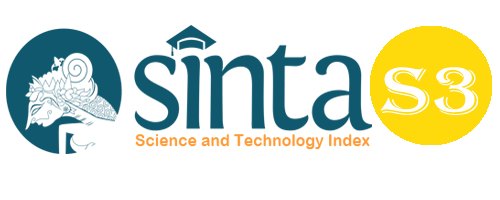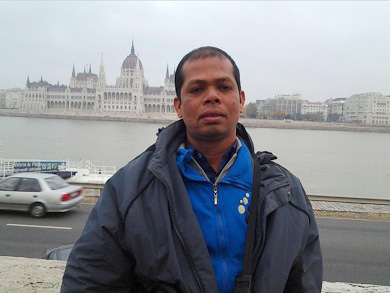The Relationship between Work Stress and Welfare in the Work Environment of employees during the COVID-19 Pandemic at PT. Saka Mitra Sejati Medan
Abstract
This study aims to determine the relationship between job stress and welfare in the work environment of employees during the Covid-19 pandemic at PT. Saka Mitra Sejati Medan. The results showed that there was a significant negative relationship between, with a value of r = -0.561 and a significance value (0.000). According to the descriptive data analysis results that have been presented, it can be seen from the mean score of the two variables, so that the difference test score can be calculated. So it can be concluded that the employees of PT. Saka Mitra Sejati Medan has low work stress and has high welfare in a work environment during the Covid-19 pandemic. Male employees have a lower mean value of work stress than women and have a higher mean value of welfare in the work environment than women. Employees with a work period of 6-8 years have the lowest mean value of work stress than employees with years of service below, and have a higher mean value of welfare in the work environment than employees with other tenure. The effective contribution of work stress variables to the welfare in the work environment is 31.5%, while the remaining 68.5% is influenced by other variables outside of this study. This can be seen from the R-square value (r2) obtained from the value of the relationship between work stress and welfare in the work environment of –0.561.
Keywords
Full Text:
PDFReferences
Adams, J. (2007). Managing People in Organizations: Contemporary Theory and Practice. Basingstoke: Palgrave Macmillan.
Akintayo, D. (2012). Occupational Stress, Psychological Well Being and Workers’ Behaviour in Manufacturing Industries in South-West Nigeria. Research Journal in Organizational Psychology & Educational Studies, 1 (5), 289-294.
Alves, S. (2005). A Study if Occupational Stress, Scope of Practice, and Collaboration in Nurse Anesthetists Practicing in Anesthesia Care Team Settings. AANA Journal, 73 (6), 443.
Anoraga, Panji. (2001). Psikologi Kerja. Jakarta: Rineka Cipta.
Ansari. (2019). Reminding State Owned Enterprises (BUMN) Management Using the Principle of ’Business Judgment Rule’: A Preliminary Note. Budapest International Research and Critics Institute-Journal (BIRCI-Journal), 27-38.
Arikunto, S. (2002). Prosedur Penelitian: Suatu Pendekatan Praktek. Jakarta: Rineka Cipta.
Badaruddin, et al. (2020). Village community empowerment through village owned enterprise based on social capital in North Sumatera, Asia Pacific Journal of Social Work and Development, DOI: 10.1080/02185385.2020.1765855
Bell, A., Rajendran, D., & Theiler. (2012). Job Stress, Wellbeing, Work-Life Balance adn Work-Life Conflict Among Australian Academics. Electronic Journal Applied Psychology, 8(1), 25-37.
Booker, O. (2004). Averting Aggression: Safe Work in Services for Adolescents and Young Adults, 2nd Edition. Lym Regis: Russel House Publishing.
Bruenette, M and Countere, S. (2013). Risk Management Behaviour of a Fourest Owner to address Growth Risk. Agricultural and Resources Economics Review 42 (2), 394-396.
CFO, I. (2016). With Integrated Risk Reporting In Place China’s Insurance Industry Continued Strong Growth. CFO Inovation Asian Staff Strategic Intelegence For Finance Risk Management.
Cooper, C. L. And Dewe, P. (2008). Wellbeing, Absenteeism & Presenteeism: Cost and Challenges. Occupational Medicine, 58 (8): 552-4.
Creswell, J. W. (2014). Research Design: Qualitative, Quantitative and Mixed Methods Approaches, 4 Edition. London: Sage.
Dantes, Nyoman. (2012). Metode Penelitian. Yogyakarta: ANDI.
Diener, E., & Lucas, R. E. (1999). Personality and Subjective Well-Being. Journal Well-Being The Foundations of Hedonic Psychology, 213-229.
Fahmi, Irham. (2013). Manajemen Kinerja, Teori dan Aplikasinya. Bandung: Alfabeta.
Gibson, James L, dkk. (2012). Organization: Behavior, Structure, Processes. 14th Edition. New York: McGraw-Hill Companies, Inc.
Handoko, Hani. (1998). Manajemen Personalia dan Manajemen Sumber Daya Manusia. BPFE: Yogyakarta.
Harter, J. K., Schmidt, F. L., & Hayes, T. L. (2002). Business‐Unit level Relationship Between Employee Satisfaction, Employee Engagement, And Business Outcomes: A Meta‐Analysis. Journal of Applied Psychology, 87, 268-79.
Hasibuan, Malayu S.P. (2011). Manajemen Sumber Daya Manusia. Jakarta: Bumi Aksara.
Hasibuan, Malayu S.P. (2014). Manajemen Sumber Daya Manusia, Edisi Revisi. Jakarta: Bumi Aksara.
Hopper, A., & Potter, J. (2000). Intelligent Leadership: Creating a Passion for Change. London: Random House.
Kun, Agota., Balogh, Peter., & Krasz, Kataline. G. (2017). Development of The Work-Related Well-Being Questionnaire Based on Seligman’s PERMA Model. Periodica Polytechnica Social and Management Sciences, 25, 1-8.
Kuswati, Y. (2019). Motivation Role in Improving Work Effectiveness. Budapest International Research and Critics Institute-Journal (BIRCI-Journal), 281-288.
Manullang, M., & Pakpahan, M. (2014). Metodologi Penelitian: Proses Penelitian Praktis. Bandung: Citapustaka Media.
Maier, G.W & Brunstein, J.C. (2001). The Role of Personal Work Goals in Newcomers, Satisfaction & Organizational Commitment. Journal of Applied Psychology, 86(5), 1024-1042
Maulana, Fikri. (2018). Pengaruh Workplace Wellbeing Terhadap Intensi Turnover Pada Karyawan. Malang: Universitas Muhammadiyah Malang.
OECD. (2010). Expert Meeting Mental Health, Disability and Work. Paris, 26-28. https://www.oecd.org/els/45008308.pdf
Olaitan, L. O., Oyerinde, O., & Kayode, O. (2010). Prevalence of Job Stress among Primary Svhool Teachers in South West, Nigeria. African Journal of Microbiology Research, 1-18.
Page, K. (2005). Subjective wellbeing in the workplace. Melbourne: Deakin University.
Page, K. M., & Vella-Brodrick, D. A. (2009). The ‘what’, ‘why’ and ‘how’ of employee well-being: A new model. Soc Indic Res, 441-458.
Pattynasarany, D. R. (2019). Apakah Tuntutan Pekerjaan dan Stres Kerja Penentu Turnover Intention Auditor pada Beberapa KAP di Jakarta. Jurnal Manajemen, 16 (1), 20-41.
Potter, P. A., dkk. (2005). Buku Ajar Fundamental Keperawatan: Konsep, Proses, dan Praktik. Ed 4. Jakarta: EGC.
Purwono, Surwono. (2006). Hubungan Masa Kerja dengan Stres kerja pada Pustakawan Perpustakaan Universitas Gadjah Mada Yogyakarta. Berkah Ilmu Perpustakaan dan Informasi, 3(1), 44-58.
Putra, B. R. (2012). Pengaruh Job Stressor Terhadap Turnover Intention dengan Kepuasan Kerja Sebagai Variabel Pemediasi. Jurnal Studi Manajemen, 1 (2), 72-81.
Putra Suwardiana, I Gd., & Artha Wibawa, I Md. (2014). Pengaruh Stres Kerja dan Komitmen Organisasi Terhadap Kepuasan Kerja Berdasarkan Gender Pada Warong Miyabi Bali. E-Jurnal Manajemen Universitas Udayana, 23 (6),2745-2766.
Resick, C. J., Whitman, D. S., Weingarden, S. M., & Hiller, N. J. (2009). The Bright-Side and The Dark Side of CEO Personality: Examining Core Self-Evaluations. Narcissism, Transformational Leadership, and Strategic Influence. Journal of Applied Psychology, 94 (6), 1365-1381.
Sabella, Rina I. (2018). Pengaruh Iklim Organisasi dan Stres Kerja Terhadap Motivasi dan Kinerja Pegawai Perusahaan Daerah Air Minum Kabupaten Sidoarjo. Dinamika Administrasi: Jurnal Ilmu Administrasi dan Manajemen, 1 (1), 80-103.
Safitri, A. E., Gilang, A. (2019). Pengaruh Stres Kerja Terhadap Produktivitas Kerja Karyawan pada PT. Telkom Witel Bekasi. Jurnal Ecodemica, 3 (2), 170-180.
Sandstrom, G, M., & Dunn, E, W. (2014). SOVIAL Interactions and Well-Being: The Surprising Power of Weak Ties. Personality and Social Psychology Bulletin.
Sandy Martha, Muhammad. (2015). Karakteristik Pekerjaan ddan Kinerja Dosen Luar Biasa UIN Sunan Gunung Djati Bandung: Komitmen Organisasi Sebagai Variabel Moderating. Bandung: Universitas Widyautama Bandung.
Seligman, M. (2011). Flourish: A Visionary New Understanding of Happiness and Well-Being. New York: Free Press.
Setiawati, Devi. (2007). Perbedaan Komitmen Kerja Berdasarkan Orientasi pada Gender Univeritas Gunadarma.
Shaufeli W, dkk. (2002). The Measurement of Engagement and Burnout: A Two Sample Confirmatory Factor Analytic Approach. Journal of Happiness Studies, 3, 71-92.
Shimazu, A., & Kosugi, S. (2003). Job stressors, Coping, and Psychological Distress Among Japanese Employees: Interplay Between Active and Non-Active Coping. Work & Stress, 17(1), 38-51.
Simamora, Henry. (2012). Manajemen Sumber Daya Manusia. Edisi 1. Yogyakarta: STIE YKPN Yogyakarta.
Sivanathan, N., Arnold, K. A., Turner, N., & Barling J. (2004). Leading Well: Transformational Leadership and Well- Being. Dalam Linley, P. A. & Joseph, S. (Eds.). Positive Psychology in Practice (241-255). New Jersey: John Wiley & Sons, Inc.
Sopiah. (2008). Perilaku Organisasional. Jakarta: C.V. Andi Offset.
Stephens, T., & Hallas, J. (2006). Bullying and Sexual Harassment. Oxford: Chandos.
Sugiyono. (2016). Metode Penelitian Kuantitatif, Kualitatif dan R&D. Bandung: PT. Alfabet.
Theobald, Theo. And Cooper, Carry. (2012). Doing The Right Thing: The Importance of Wellbeing in the Workplace. London: Palgrave Macmillan.
Thompson, N. (2009). Loss, Grief and Trauma in the Workplace. Amityville, New York: Baywood.
Thompson, Neil., & Bates, John. (2009). Promoting Workplace Well-Being. London: Palgrave Macmillan.
Velnampy, T., & Aravinthan, S, A. (2013). Occupational Stress and Organizational Commitment in Private Banks. European Journal of Bussiness and Mangement, 5.
Vigoda, Eran. (2002). Stress-Related Aftermatsh to Workplace Politics: An Empirical Assesment of The Relationship Among Organizational Politics, Job Stress, Burnout, and Aggressive Behavior. Journal of Organizationa Behavior, 23, 571-591.
Waluyo, Minto. (2013). Psikologi Industri. Jakarta: Akademia Permata.
World Health Organization. (1986). The Ottawa Charter for Health Promotion Ottawa.
https://cwa-union.org/national-issues/health-and-safety/health-and-safety-fact-sheets/occupational-stress-and-workplace diakses pada 22 September 2019.
https://www.who.int/occupational_health/topics/stressatwp/en/ diakses pada 22 September 2019.
DOI: https://doi.org/10.33258/birci.v3i4.1404
Article Metrics
Abstract view : 638 timesPDF - 279 times
Refbacks
- There are currently no refbacks.

This work is licensed under a Creative Commons Attribution-ShareAlike 4.0 International License.

This work is licensed under a Creative Commons Attribution-ShareAlike 4.0 International License.

_.gif)

















_.gif)



